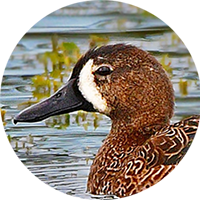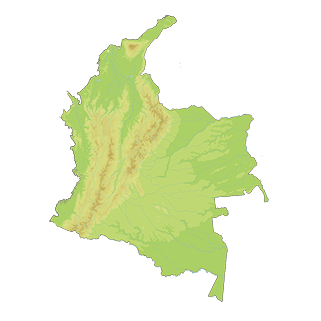Blue-winged Teal
Size and Appearance: Blue-winged Teals are small ducks, with males (drakes) measuring about 14-16 inches (36-41 cm) in length and females (hens) slightly smaller. They have a streamlined body shape with a compact head and a moderately long neck. Adult birds have a distinctive plumage during the breeding season, while hens and non-breeding males have a more subtle appearance.
Head and Bill: Males have a rich chestnut-colored head with a broad vertical white crescent in front of the eye and a dark cap. They also possess a light blue spot on the forewing, which is visible during flight. The bill is grayish-black and relatively small. Females have a mottled brown head with a less pronounced eye crescent and a narrower bill.
Body Plumage: Male Blue-winged Teals have a vibrant patterned plumage. The chest is light to medium brown, transitioning to a greyish back with fine black speckles. The sides of the body are marked with vertical black and white stripes. Hens and non-breeding males have mottled brown plumage, providing good camouflage.
Wings and Tail: During flight, Blue-winged Teals reveal a prominent blue patch on the upperwing, bordered by a white bar and a black line. The flight feathers are dark with a contrasting white patch called the speculum. The tail is short and pointed.
Behavior and Habitat: Blue-winged Teals prefer shallow wetland habitats such as marshes, ponds, and shallow lakes. Can be found in shallow fresh and saltwater habitats. They are dabbling ducks, feeding by upending their bodies to reach submerged vegetation and invertebrates. They are agile flyers and often gather in large flocks during migration.
Conservation: The
Distribution
The distribution of the Blue-winged Teal in Colombia is associated with wetland habitats, including marshes, lagoons, lakes, and estuaries. During the non-breeding season, which generally occurs from September to April, large numbers of Blue-winged Teals migrate to Colombia from their breeding grounds in North America. They can be found in various regions throughout the country, including the Magdalena River Valley, the Cauca River Valley, and the coastal areas along the Caribbean and Pacific coasts.
Colombia's wetlands, such as those in the Ciénaga Grande de Santa Marta, the Laguna de la Cocha, and the Ciénaga de Ayapel, attract significant populations of Blue-winged Teals during this time. These wetlands provide suitable foraging and resting areas for the ducks as they spend their winter months in Colombia.
Taxonomy
- Kingdom: Animalia
- Phylum: Chordata
- Class: Aves
- Order: Anseriformes
- Family: Anatidae
- Genus: Spatula
- Species: Spatula discors
Vocalization
Male Whistle: During the breeding season, the male Blue-winged Teal emits a high-pitched, descending whistle that sounds like "tee-lee-lee" or "teek-teeek". This call is often repeated rapidly several times in a row.
Female Call: The female Blue-winged Teal produces a softer, shorter version of the male's whistle, typically a low, raspy "kerrr".
Chatter: Blue-winged Teals are known to create a rapid, chattering call during courtship displays. This chatter consists of a series of quick, staccato notes.
Alarm Calls: When disturbed or alert to potential danger, Blue-winged Teals may emit a rapid series of high-pitched, short notes that sound like a repeated "pip".







